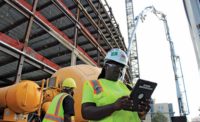Overhead, an El train rumbles across Chicago's Devon-Sheridan viaduct. Below, amid cracks, spalls and exposed rebar, a network of strain gauges measures the amount of stress that has shifted from the original concrete structure to new supplementary steel shoring.
As the structure continues to deteriorate, primarily from exposure to deicing chemicals, the steel columns and their concrete footings are expected to absorb more of the loading imposed by trains, the roadbed and the structure itself.
The gauges measure the elastic movement of the steel columns each time a train crosses the overpass—as many as 450 times a day. The greater the movement, the more uncertain the long-term prospects for the roughly 100-year-old viaduct—one of hundreds of the same vintage along 36 miles of elevated track.
By a Hair
To date, the amount of elastic movement has been miniscule—about 305 millionths of an inch per train, or about one-tenth of the diameter of a human hair.
"The good news is that the rail system originally was built to support freight trains, so it's over-designed for the types of loads imposed upon it today," says Dave Kosnick, research engineer with Northwestern University's Infrastructure Technology Institute in Evanston, Ill., which is monitoring the structural health of the aging overpass with funding from the U.S. Dept. of Transportation.
Had the Chicago Transit Authority (CTA) attempted to measure the elastic movement of the columns five years ago, sensors available at the time would have been incapable of detecting strains as minute as those captured at Devon-Sheridan. The CTA is putting the new technology to innovative uses.
Like many other public entities, the agency neither has the funds required to fully address problems associated with its aging rail lines nor is it able to continually monitor their structural health, which is what makes Devon-Sheridan unique.
Data culled from the study will be used to develop models to predict the long-term performance of the viaduct. The findings also will help CTA develop simpler and less costly studies of hundreds of other similar structures so that agency engineers can better determine if or when repairs or replacements are warranted.
"The comprehensive data set derived from the Devon-Sheridan study will allow the CTA to interpret simpler data gathered by less expensive means," says Daniel Marron, chief research engineer with Northwestern's research institute. "We're currently in the process of determining what the study's most representative data are, so we can use the data as a basis for developing simpler monitoring methods."






Post a comment to this article
Report Abusive Comment